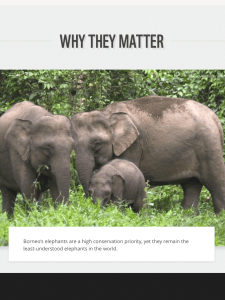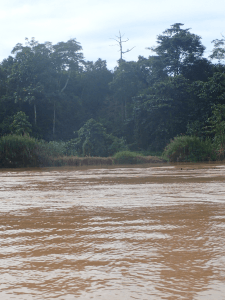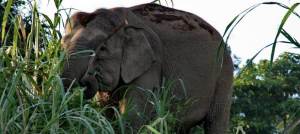
Janet told us that the pygmy elephants come to Tungog Lake on their migration path; this is one of the last stops they make before turning around and heading back to the mountains. The ecocamp sits between the Tungog Lake and the Kinabatanga River. The whole class was excited with the anticipation of the possibility of pygmy elephants coming near the camp. By the third day however, we had not seen the elephants nor were there sightings on the Kinabatangan River by the camp. When we inquired about the late arrival of the elephants, no one could give us an answer therefore Martin and Gretchen decided that we would take an hour and a half boat ride down the Kinabatangan River in hopes of seeing the elephants where they had last been sighted drinking and playing in the river. As we traveled down the river we could see the paths the pygmy elephants had taken to reach the river – the vegetation (mostly tall grasses) was compacted, broken and/or completely cleared, leaving a muddy bank behind.

Every bend we came around we held our breathe for even a small glimpse of these amazing creatures. As we traveled down the river we passed other boats also wanting to spot these animals. Some of these boats were making loud noises that we came to understand as elephant calls. When we asked Faizal, one of our local KOPEL guides, he explained that these other guides were making a call to draw out the elephants. The noise is supposed to be that of a distressed baby elephant so that the elder elephants come looking for it. Once we heard this, our boat became silent. The realization that we were disturbing these beautiful creatures on their migratory path became very clear. We floated on the river watching the bank and gasping at every rustle in the bushes.

After an hour we decided to turn back. The ride back to the ecocamp was silent, many of us contemplating our roles in the jungle and how to balance observing the wildlife without disrupting them. Once back at the ecocamp we learned the reason the elephants didn’t make it up to Tungog Lake. Other tourist spots along the river wanted to keep the elephants in their area longer so they set off fire crackers to keep the elephants from moving forward or backwards on their route. For a second time that day the class became silent digesting the news. Later we discussed that we were glad we had not seen these majestic creatures and that they had stayed hidden in the jungle so that they would not be disturbed. We also discussed the inner conflict of wanting to see the rare pygmy elephant in its natural habitat, but not at the expense of the animal. The quest for the pygmy elephants only strengthened the classes desire to help KOPEL in the quest of restoring and conserving the tropical forest.
Check out this video on elephant conservation:
Conservation video on Pygmy Elephants
Tara Morin
